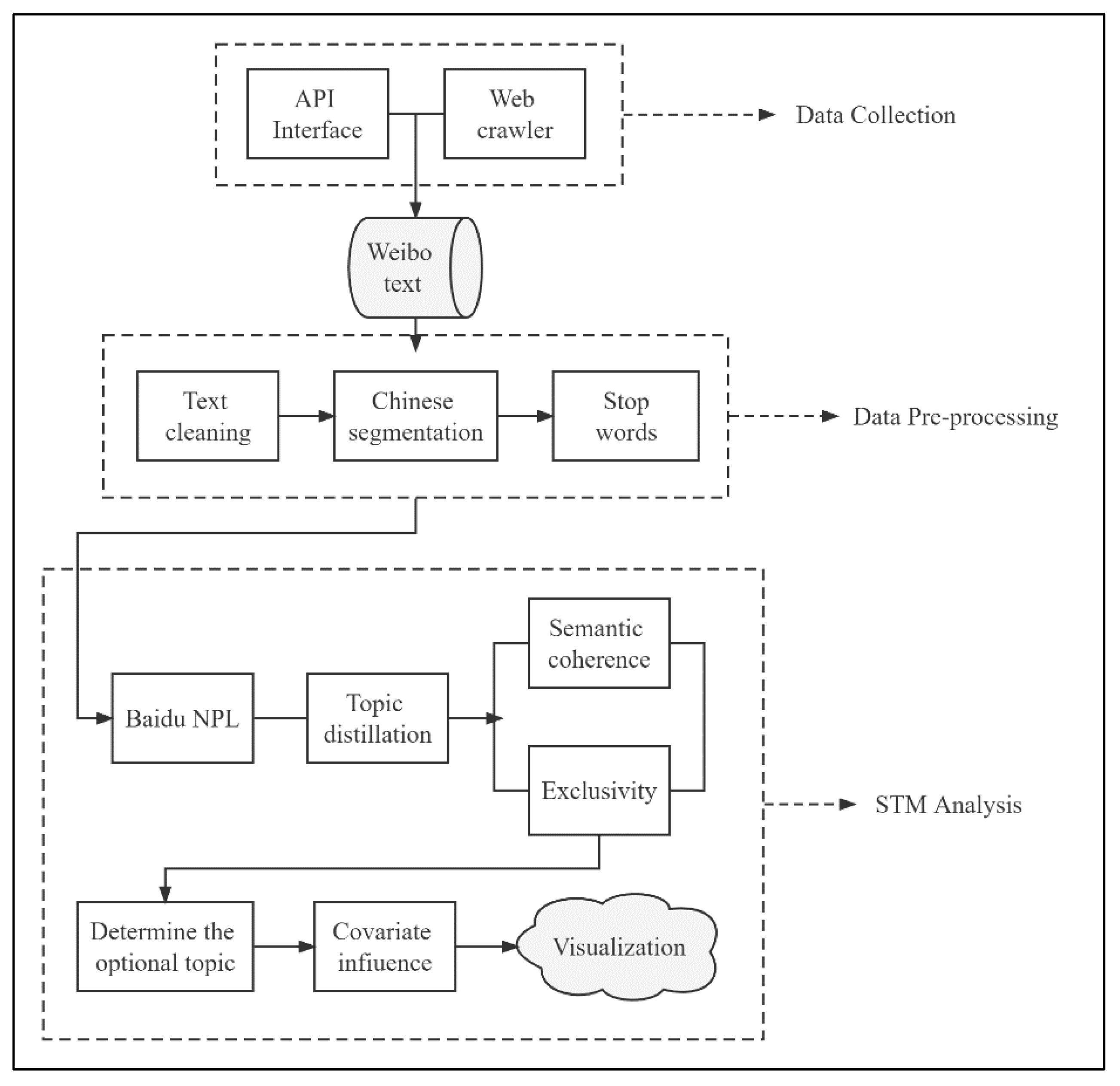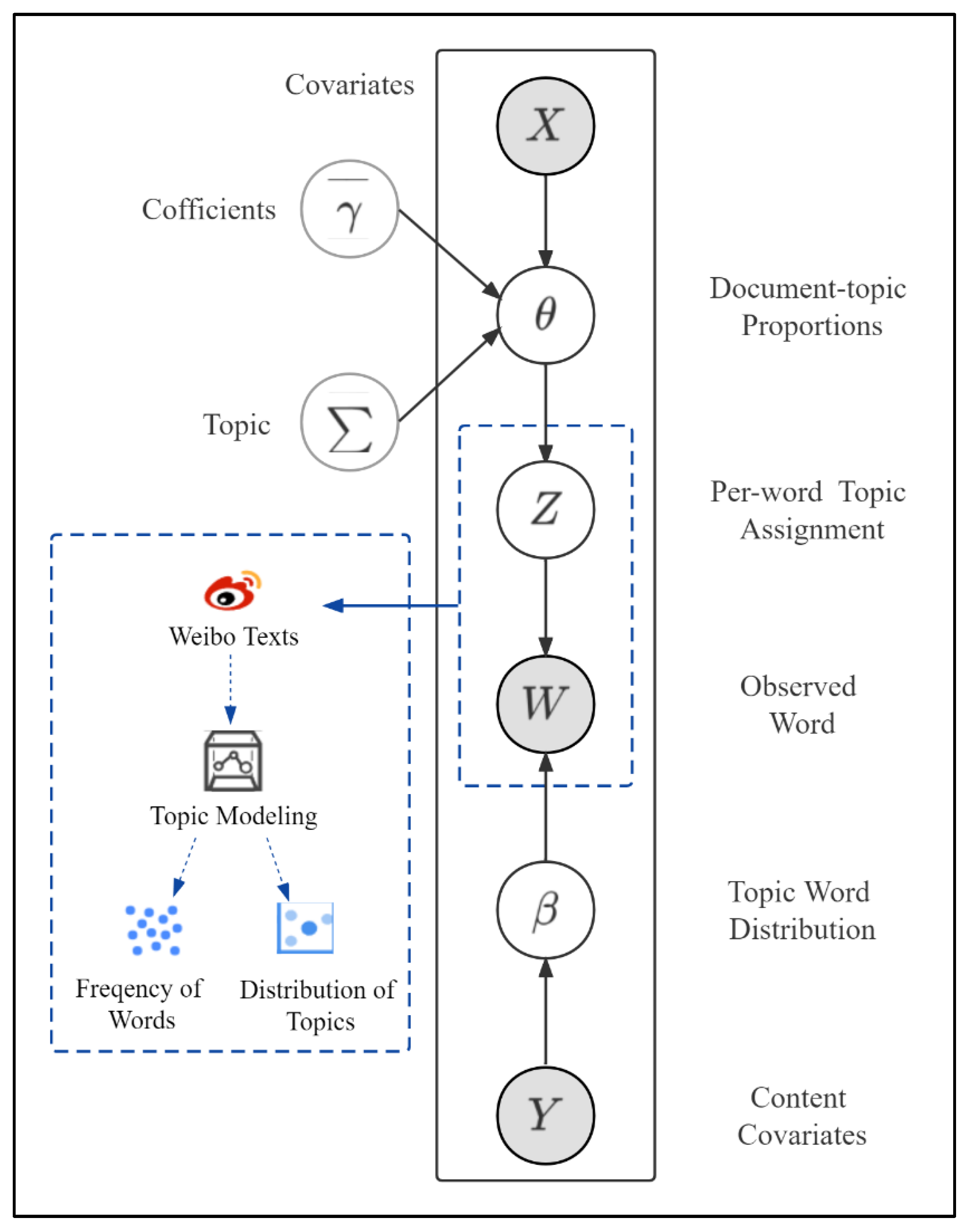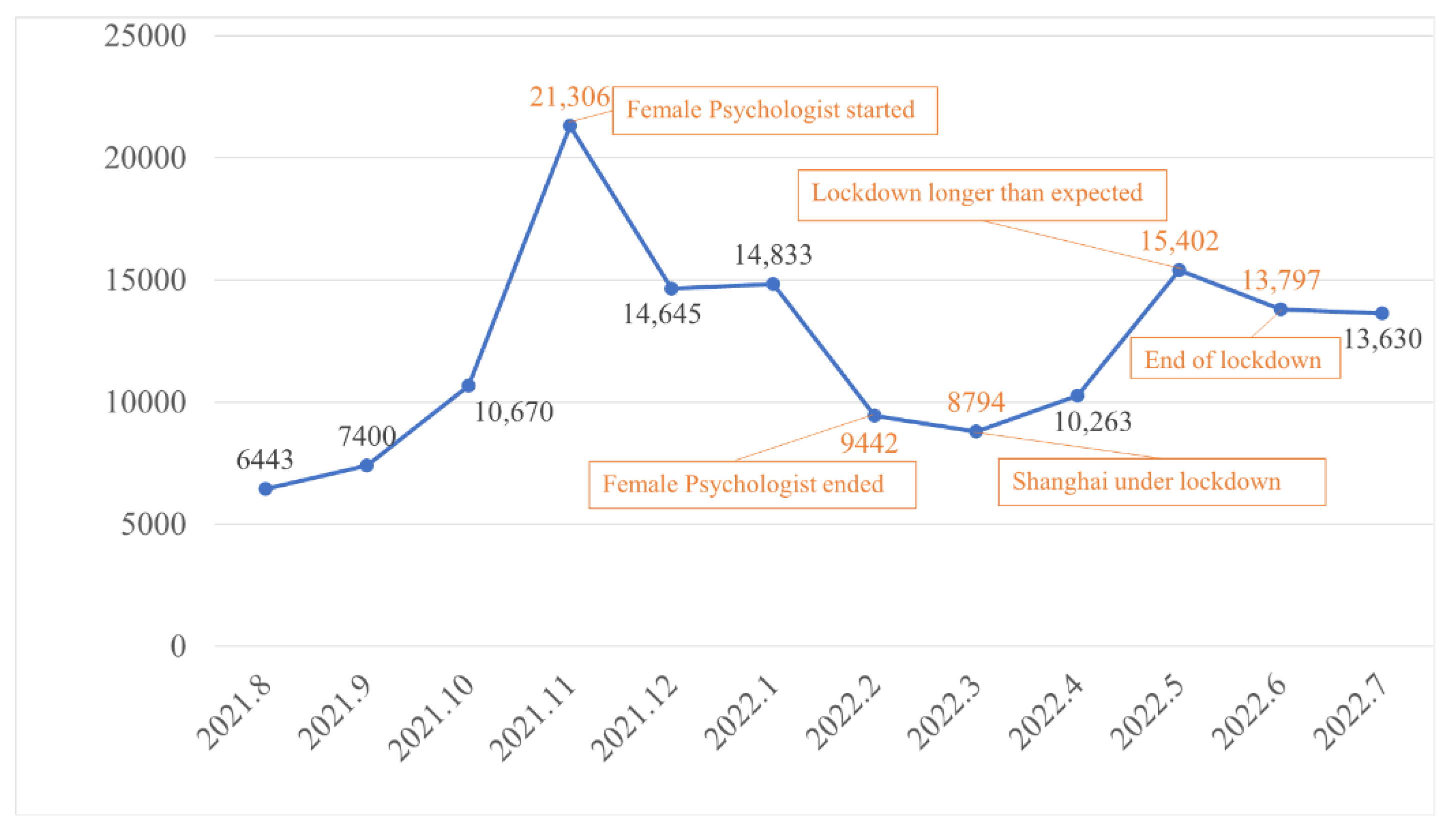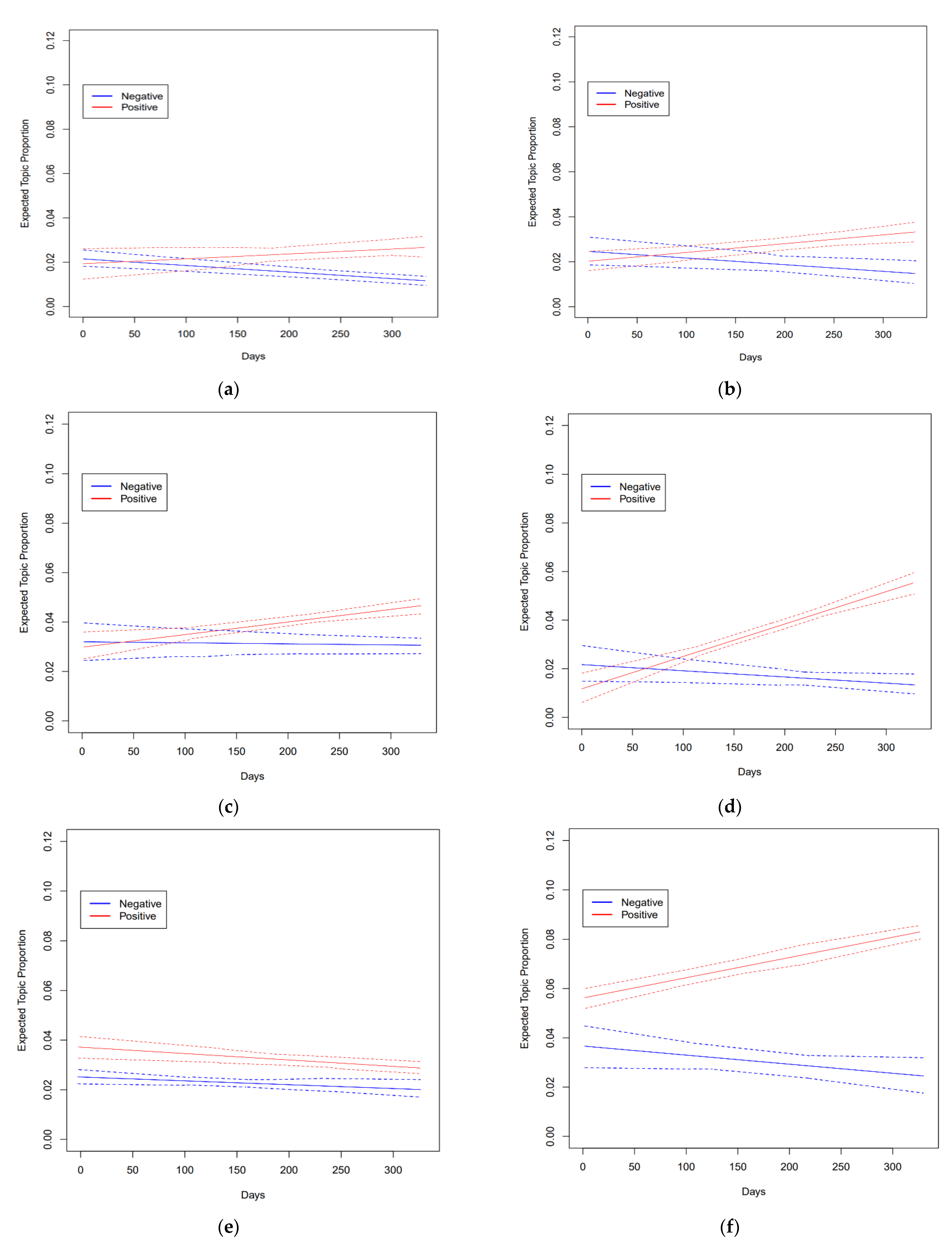Exploring the Factors Associated with Mental Health Attitude in China: A Structural Topic Modeling Approach
Abstract
:1. Introduction
2. Literature Review
3. Methodology
3.1. Data Collection and Processing
3.2. STM Model Setup
4. Results
4.1. General Description
4.2. Topic Summary
4.3. Topic Sentiment Polarity Identification
4.4. Topic Sentiment Polarity Variations
5. Discussion
6. Conclusions
Author Contributions
Funding
Data Availability Statement
Conflicts of Interest
References
- Huang, Y.; Wang, Y.; Wang, H.; Liu, Z.; Yu, X.; Yan, J.; Wu, Y. Prevalence of mental disorders in China: A cross-sectional epidemiological study. Lancet Psychiatry 2019, 6, 211–224. [Google Scholar] [CrossRef]
- Ren, Y.; Qian, W.; Li, Z.; Liu, Z.; Zhou, Y.; Wang, R.; Qi, L.; Yang, J.; Song, X.; Zeng, L. Public mental health under the long-term influence of COVID-19 in China: Geographical and temporal distribution. J. Affect. Disord. 2020, 277, 893–900. [Google Scholar] [CrossRef]
- Liu, T.; Li, S.; Qiao, X.; Song, X. Longitudinal change of mental health among active social media users in China during the COVID-19 outbreak. Healthcare 2021, 9, 833. [Google Scholar] [CrossRef]
- Zhao, N.; Wang, Y.; Li, S.; Liu, X.; Wu, P.; Zhu, T. Impact of Wuhan city lockdowns on psychology and behavior among general population. Bull. Chin. Acad. Sci. 2020, 035, 264–272. [Google Scholar]
- Zhang, W.R.; Wang, K.; Yin, L.; Zhao, W.F.; Xue, Q.; Peng, M.; Min, B.Q.; Tian, Q.; Leng, H.X.; Du, J.L.; et al. Mental health and psychosocial problems of medical health workers during the COVID-19 epidemic in China. Psychother. Psychosomr. 2020, 89, 242–250. [Google Scholar] [CrossRef]
- Liu, N.; Zhang, F.; Wei, C.; Jia, Y.; Shang, Z.; Sun, L.; Wu, L.; Sun, Z.; Zhou, Y.; Wang, Y.; et al. Prevalence and predictors of PTSS during COVID-19 outbreak in China hardest- hit areas: Gender differences matter. Psychiatry Res. 2020, 287, 112921. [Google Scholar] [CrossRef]
- Wang, C.; Pan, R.; Wan, X.; Tan, Y.; Xu, L.; McIntyre, R.S.; Choo, F.N.; Tran, B.; Ho, R.; Sharma, V.K.; et al. A longitudinal study on the mental health of general population during the COVID-19 epidemic in China. Brain Behav. Immun. 2020, 87, 40–48. [Google Scholar] [CrossRef]
- Shi, L.; Lu, Z.A.; Que, J.Y.; Huang, X.L.; Lu, Q.D.; Liu, L.; Zheng, Y.B.; Liu, W.J.; Ran, M.S.; Yuan, K.; et al. Long-Term impact of COVID-19 on mental health among the general public: A nationwide longitudinal study in China. Int. J. Environ. Res. Public Health 2021, 18, 87–90. [Google Scholar]
- Hao, F.; Tan, W.; Jiang, L.; Zhang, L.; Zhao, X.; Zou, Y.; Hu, Y.; Luo, X.; Jiang, X.; McIntyre, R.S.; et al. Do psychiatric patients experience more psychiatric symptoms during COVID-19 pandemic and lockdown? A case-control study with service and research implications for immunopsychiatry. Brain Behav. Immun. 2020, 87, 100–106. [Google Scholar] [CrossRef]
- Lee, H.Y.; Hwang, J.; Ball, J.G.; Lee, J.; Yu, Y.; Albright, D.L. Mental health literacy affects mental health attitude: Is there a gender difference? Am. J. Health Behav. 2020, 3, 282–291. [Google Scholar] [CrossRef] [PubMed]
- Ten Have, M.; de Graaf, R.; Ormel, J.; Vilagut, G.; Kovess, V.; Alonso, J. Are attitudes towards mental health help-seeking associated with service use? Results from the European study of epidemiology of mental disorders. Soc. Psychiatry Psychiatr. Epidemiol. 2010, 45, 153–163. [Google Scholar] [CrossRef] [PubMed] [Green Version]
- Jung, H.; von Sternberg, K.; Davis, K. The impact of mental health literacy, stigma, and social support on attitudes toward mental health help-seeking. Int. J. Ment. Health Promot. 2017, 5, 252–267. [Google Scholar] [CrossRef]
- Reavley, N.J.; Jorm, A.F. Recognition of mental disorders and beliefs about treatment and outcome: Findings from an Australian National Survey of Mental Health Literacy and Stigma. Aust. N. Z. J. Psychiatry 2011, 11, 947–956. [Google Scholar] [CrossRef] [PubMed]
- Li, J.; Duan, X.L.; Zhong, H.Q.; Chen, W.; Evans-Lacko, S.; Thornicroft, G. Cross-sectional study of mental health related knowledge and attitudes among care assistant workers in Guangzhou, China. Int. J. Ment. Health Sys. 2021, 15, 1–9. [Google Scholar] [CrossRef]
- West, K.; Hewstone, M.; Holmes, E.A. Rethinking “mental health stigma”. Eur. J. Public Health 2010, 2, 131–132. [Google Scholar] [CrossRef]
- Corrigan, P.; Thompson, V.; Lambert, D.; Sangster, Y.; Noel, J.G.; Campbell, J. Perceptions of discrimination among persons with serious mental illness. Psychiatr. Serv. 2003, 8, 1105–1110. [Google Scholar] [CrossRef]
- Bradbury, A. Mental health stigma: The impact of age and gender on attitudes. Community Ment. Health J. 2020, 5, 933–938. [Google Scholar] [CrossRef]
- Kotera, Y.; Gilbert, P.; Asano, K.; Ishimura, I.; Sheffield, D. Self-criticism and self-reassurance as mediators between mental health attitudes and symptoms: Attitudes toward mental health prob-lems in Japanese workers. Asian J. Soc. Psychol. 2019, 22, 183–192. [Google Scholar] [CrossRef]
- Geldsetzer, P. Use of rapid online surveys to assess people’s perceptions during infectious disease outbreaks: A cross-sectional survey on COVID-19. J. Med. Internet Res. 2020, 22, e18790. [Google Scholar] [CrossRef]
- Munro, N. Does refusal bias influence the measurement of Chinese political trust. J. Contemp. China 2018, 27, 457–471. [Google Scholar] [CrossRef] [Green Version]
- Gruebner, O.; Lowe, S.R.; Sykora, M.; Shankardass, K.; Subramanian, S.; Galea, S. A novel surveillance approach for disaster mental health. PLoS ONE 2017, 7, e0181233. [Google Scholar] [CrossRef] [PubMed] [Green Version]
- McCormick, T.; Lee, H.; Cesare, N.; Shojaie, A.; Spiro, E. Using Twitter for demographic and social science research: Tools for data collection and processing. Sociol. Methods Res. 2015, 46, 390–421. [Google Scholar] [CrossRef] [PubMed]
- Stieglitz, S.; Mirbabaie, M.; Ross, B.; Neuberger, C. Social media analytics: Challenges in topic discovery, data collection, and data preparation. Int. J. Inf. Manag. 2018, 39, 156–168. [Google Scholar] [CrossRef]
- Vosoughi, S.; Roy, D.; Aral, S. The spread of true and false news online. Science 2018, 359, 1146–1151. [Google Scholar] [CrossRef]
- Yang, F.; Wendorf, M.J.; Yang, Q. Exploring environmental health on Weibo: A textual analysis of framing haze-related stories on Chinese social media. Int. J. Env. Res. Public Health 2019, 4, 2374. [Google Scholar] [CrossRef] [Green Version]
- Weibo’s Q1 2022 Financial Results. Weibo Quarterly Reports. Available online: http://ir.weibo.com/financial-information/quarterly-results/ (accessed on 12 July 2022).
- Zhou, M. Public opinion on MOOCs: Sentiment and content analyses of Chinese microblogging data. Behav. Inf. Technol. 2010, 41, 1–18. [Google Scholar] [CrossRef]
- Tian, X.; Batterham, P.; Song, S.; Yao, X.; Yu, G. Characterizing depression issues on Sina Weibo. Int. J. Environ. Res. Public Health 2018, 15, 764. [Google Scholar] [CrossRef] [Green Version]
- He, L.; Han, D.; Zhou, X.; Qu, Z. The voice of drug consumers: Online textual review analysis using structural topic model. Int J. Environ. Res. Public Health 2020, 10, 3648. [Google Scholar] [CrossRef]
- Zhong, Z. Internet public opinion evolution in the COVID-19 event and coping strategies. Disaster Med. Public Health Prep. 2013, 6, 27–33. [Google Scholar] [CrossRef]
- Xiong, J.; Hswen, Y.; Naslund, J.A. Digital surveillance for monitoring environmental health threats: A case study capturing public opinion from Twitter about the 2019 Chennai Water Crisis. Int. J. Environ. Res. Public Health 2020, 17, 5077. [Google Scholar] [CrossRef]
- Liu, Q.; Liang, Y.; Wang, S.; Huang, Z.; Wang, Q.; Jia, M.; Li, Z.; Ming, W.K. Health communication through Chinese media on E-Cigarette: A topic modeling approach. Int. J. Environ. Res. Public Health 2022, 19, 7591. [Google Scholar] [CrossRef] [PubMed]
- Roberts, M.E.; Stewart, B.M.; Tingley, D. Stm: An R package for structural topic models. J. Stat. Softw. 2019, 91, 1–40. [Google Scholar] [CrossRef]
- Pirri, S.; Lorenzoni, V.; Andreozzi, G.; Mosca, M.; Turchetti, G. Topic modeling and user network analysis on Twitter during World Lupus Awareness Day. Int. J. Environ. Res. Public Health 2020, 17, 5440. [Google Scholar] [CrossRef] [PubMed]
- Tian, H.; Gao, C.; Xiao, X.; Liu, H.; He, B.; Wu, H.; Wu, F. SKEP: Sentiment knowledge enhanced pre-training for sentiment analysis. In Proceedings of the 58th Annual Meeting of the Association for Computational Linguistics, Online, 5–10 July 2020; pp. 4067–4076. [Google Scholar]
- Hu, N.; Zhang, T.; Gao, B.; Bose, I. What do hotel customers complain about? Text analysis using structural topic model. Tour. Manag. 2019, 72, 417–426. [Google Scholar] [CrossRef]
- Mimno, D.; Wallach, H.M.; Talley, E.; Leenders, M.; McCallum, A. Optimizing semantic coherence in topic models. In Proceedings of the 2011 Conference on Empirical Methods in Natural Language Processing, Scotland, UK, 27–31 July 2011; pp. 262–272. [Google Scholar]
- Roberts, M.E.; Stewart, B.M.; Tingley, D.; Lucas, C.; Leder-Luis, J.; Gadarian, S.K.; Albertson, B.; Rand, D.G. Structural topic models for open-ended survey responses. Am. J. Political Sci. 2014, 58, 1064–1082. [Google Scholar] [CrossRef] [Green Version]
- Zhao, M. Female Psychologist: Advocating Mental Health in China. Available online: http://bj.news.cn/2021–12/08/c_1128143042.htm (accessed on 2 September 2022).
- Xinhua. Shanghai Tightens COVID-19 Control Measures Amid Resurgence. Available online: https://www.chinadaily.com.cn/a/202203/28/WS6240f41ea310fd2b29e538d4.html (accessed on 2 September 2022).
- Su, Y.; Jin, J.; Zhu, L.; Cai, J. Emerging psychological crisis issues during lockdown in Shanghai. Lancet Reg. Health–West. Pac. 2022, 25, 100536. [Google Scholar] [CrossRef]
- Hao, H.; Zhang, K. The voice of Chinese health consumers: A text mining approach to web-based physician reviews. J. Med. Internet Res. 2016, 18, 8–10. [Google Scholar] [CrossRef]
- Sutherland, I.; Sim, Y.; Lee, S.K.; Byun, J.; Kiatkawsin, K. Topic modeling of online accommodation reviews via latent dirichlet allocation. Sustainability 2020, 12, 1821. [Google Scholar] [CrossRef] [Green Version]
- Korfiatis, N.; Stamolampros, P.; Kourouthanassis, P.; Sagiadinos, V. Measuring service quality from unstructured data: A topic modeling application on airline passengers’ online reviews. Expert Syst. Appl. 2019, 116, 472–486. [Google Scholar] [CrossRef] [Green Version]
- Aikman, K.; Burtt, L.; Ronde, O.D.; Lim, D.K.W.; Stratton, P.; Wong, M.H.; Grainger, R.; Devan, H. Mass media campaigns for chronic pain: A scoping review to inform design of future campaigns. Phys. Ther. Rev. 2020, 25, 331–349. [Google Scholar] [CrossRef]
- Corrigan, P.W.; Kuwabara, S.A.; O’Shaughnessy, J. The public stigma of mental illness and drug addiction: Findings from a stratified random sample. J. Soc. Work. 2009, 2, 139–147. [Google Scholar] [CrossRef]
- Bharadwaj, P.; Pai, M.M.; Suziedelyte, A. Mental health stigma. Econ. Lett. 2017, 159, 57–60. [Google Scholar] [CrossRef]
- Corrigan, P. How stigma interferes with mental health care. Am. Psychol. 2004, 59, 614–625. [Google Scholar] [CrossRef] [PubMed] [Green Version]
- Eisenberg, D.; Downs, M.F.; Golberstein, E.; Zivin, K. Stigma and help seeking for mental health among college students. Med. Care Res. Rev. 2009, 66, 522–541. [Google Scholar] [CrossRef] [PubMed]
- Holmes, E.A.; O’Connor, R.C.; Perry, V.H.; Tracey, I.; Wessely, S.; Arseneault, L.; Everall, I. Multidisciplinary research priorities for the COVID-19 pandemic: A call for action for mental health science. Lancet Psychiatry 2020, 6, 547–560. [Google Scholar] [CrossRef]
- Jorm, A.F. Mental health literacy: Public knowledge and beliefs about mental disorders. Br. J. Psychiatry 2000, 177, 396–401. [Google Scholar] [CrossRef] [Green Version]
- Desai, S.; Jena, A.B. Do celebrity endorsements matter? Observational study of BRCA gene testing and mastectomy rates after Angelina Jolie’s New York Times editorial. BMJ 2016, 355, 57–63. [Google Scholar] [CrossRef] [Green Version]
- Hart, P.S.; Leiserowitz, A.A. Finding the teachable moment: An analysis of information-seeking behavior on global warming related websites during the release of The Day After Tomorrow. Environ. Commun. 2009, 3, 355–366. [Google Scholar] [CrossRef]
- Hidi, S.; Renninger, A. The four-phase model of interest and achievement of interest development. Educ. Psychol. 2016, 41, 111–127. [Google Scholar] [CrossRef]
- Chu, J.P.; Sue, S. Asian American mental health: What we know and what we don’t know. Online Read. Psychol. Cult. 2011, 3, 4. [Google Scholar] [CrossRef] [Green Version]
- Snowden, L.R. Explaining mental health treatment disparities: Ethnic and cultural differences in family involvement. Cult. Med. Psychiatry 2007, 31, 389–402. [Google Scholar] [CrossRef] [PubMed]
- Woodward, A.; Taylor, R.J.; Neighbors, H.; Chatters, L.; Jackson, J. Use of professional and informal support by African Americans and Caribbean blacks with mental disorders. Psychiatr. Serv. 2008, 59, 1292–1298. [Google Scholar] [CrossRef] [PubMed]






| Number | Labels | Proportion | Top Words |
|---|---|---|---|
| 1 | Information seeking | 6.66% | mental health, learn, medicine, hospital, Baidu |
| 2 | Advice and sharing | 8.36% | spread, share, WeChat, private massage, get |
| 3 | Media promotion | 8.02% | television, education, promotion, postpartum depression, effective |
| 4 | Celebrity effect | 10.78% | Yang Zi, celebrity, endorse, awareness, attention |
| 5 | Community effect | 6.39% | prevalence, globe, normal, group, help |
| 6 | Public stigma | 16.73% | career, pain, housing, fear, anguish |
| 7 | Self-stigma | 7.28% | doubt, fault, disappoint, own, loneliness |
| 8 | Mental health service | 6.77% | support, donation, family, work, community |
| 9 | Patient stories | 13.20% | lockdown, quarantine, Shanghai, discrimination, job |
| 10 | Encouragement | 6.70% | fighting, strong, faith, warrior, amazing |
| 11 | World Mental Health Day | 2.17% | Mental Health Day, today, involvement, success, campaign |
| 12 | Symptoms description | 6.94% | physical, anxiety, depression, anger, sad |
| Information seeking (topic 1): “Which hospital has the best mental health treatment?”; “Which doctor is best at dealing with postpartum depression?”; “Baidu is full of advertisements. Where can I find some useful information?” |
| Advice and sharing (topic 2): “Help me spread the awareness for mental health!”; “There’s this WeChat group I’m in that people share mental health information everyday”; “You can get useful tips for coping with mental health problems at this website.” |
| Media promotion (topic 3): “Television is so effective in promoting mental health awareness.”; “Female Psychologist is really good mental health education.”; “Whoever in charge of mental health should pay attention to the advantage of media promotion.” |
| Celebrity effect (topic 4): “So many celebrities are advocating mental health right now.”; “I’m a huge fan of Yang Zi. I will followed her lead to help those with mental health problems.”; “Yang Zi is the reason why I pay attention to mental health.” |
| Community effect (topic 5): “Mental health problems are so prevalent. We are not alone.”; “Mental health affects people of all nationalities, races, ethnicities, genders and ages.”; “Thousands of Millions of people have mental health problems globally.” |
| Public stigma (topic 6): “I might lose my job if my boss knows I have mental health problems.”; “They think I’m some kind of a lunatic.”; “My career will be over if anyone knows I am taking mental health treatment.” |
| Self-stigma (topic 7): “I’m so vulnerable. I let myself stuck in this position. I’m feeling depressed lately. But I don’t need to seek help. That’s what cowards do.”; “Why they are perfectly fine with the pressure? Am I the only one feeling mentally unwell?” |
| Mental health service (topic 8): “China has more than 16 million mental health patients. It is imperative to improve mental health services”; “I’m so glad that there are so many mental health resources in my disposal.”; “The government needs to up its game in providing social support to people.” |
| Patient stories (topic 9): “Last two years is the most difficult time of my life.”; “This is such a tragedy. We must prevent it from happening again to someone else.”; “I moved seven times last year to run away from the discrimination. ” |
| Encouragement (topic 10): “Keep fighting! You are not alone!”; “You guys are the true warriors.”; “You guys are amazing! Keep the faith.” |
| World Mental Health Day (topic 11): “Let’s join together to fight mental health problems! #WorldMentalHealthDay.”; “To all those living with mental health problems around the world, keep fighting! #WorldMentalHealthDay”; “We encourage ALL our policymakers to promote World Mental Health Day.” |
| Symptoms description (topic 12): “You should seek mental health care once you have the following symptoms.”; “I didn’t know there would be physical symptoms. Nauseous all the time…”; “Physical symptoms is the hardest part of mental health problems.” |
Publisher’s Note: MDPI stays neutral with regard to jurisdictional claims in published maps and institutional affiliations. |
© 2022 by the authors. Licensee MDPI, Basel, Switzerland. This article is an open access article distributed under the terms and conditions of the Creative Commons Attribution (CC BY) license (https://creativecommons.org/licenses/by/4.0/).
Share and Cite
Yin, R.; Tian, R.; Wu, J.; Gan, F. Exploring the Factors Associated with Mental Health Attitude in China: A Structural Topic Modeling Approach. Int. J. Environ. Res. Public Health 2022, 19, 12579. https://doi.org/10.3390/ijerph191912579
Yin R, Tian R, Wu J, Gan F. Exploring the Factors Associated with Mental Health Attitude in China: A Structural Topic Modeling Approach. International Journal of Environmental Research and Public Health. 2022; 19(19):12579. https://doi.org/10.3390/ijerph191912579
Chicago/Turabian StyleYin, Ruheng, Rui Tian, Jing Wu, and Feng Gan. 2022. "Exploring the Factors Associated with Mental Health Attitude in China: A Structural Topic Modeling Approach" International Journal of Environmental Research and Public Health 19, no. 19: 12579. https://doi.org/10.3390/ijerph191912579
APA StyleYin, R., Tian, R., Wu, J., & Gan, F. (2022). Exploring the Factors Associated with Mental Health Attitude in China: A Structural Topic Modeling Approach. International Journal of Environmental Research and Public Health, 19(19), 12579. https://doi.org/10.3390/ijerph191912579







